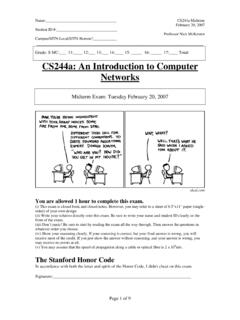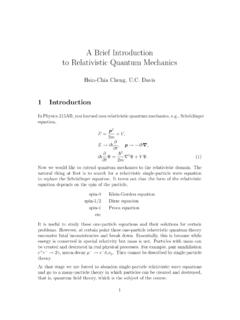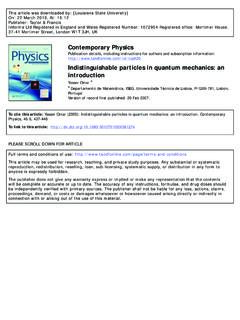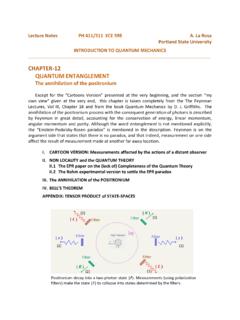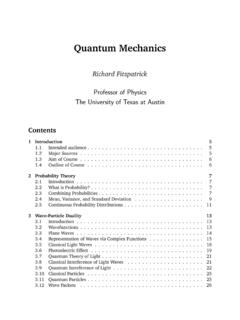Transcription of Lecture #3 Quantum Mechanics: Introduction
1 1 Lecture #3 Quantum mechanics : Introduction Topics Why QM for magnetic resonance? Historical developments Wavefunctions Handouts and Reading assignments Levitt, Chapter 6 (optional) Miller, Chapter 1-3 (optional).2 Classical versus Quantum NMR QM is only theory that correctly predicts behavior of matter on the atomic scale, and QM effects are seen in vivo. Systems of isolated nuclei can be described with the intuitive picture of a classical magnetization vector rotating in 3D space (Bloch equations). Systems of interacting nuclei, in particular spin-spin coupling, require a more complete QM description (density matrix theory). We will develop a QM analysis of MR, based on density matrix theory, but retaining the intuitive concepts of classical vector models (product operator formalism).319th Century Physics At the end of the 19th century, physicists divided the world into two entities:Electromagnetic Fields & WavesMatterNewtonian MechanicsLorentz ForceMaxwell s EquationsClassical Physics4 Early 20th Century PhysicsClassicalPhysicsRemains valid for velocities << c and macroscopic dimensions Relativistic QuantumMechanicsAnalogy: geometric optics versus inclusion of diffraction effectsNot used in this class (except for one important result).
2 RelativityvelocityQuantumMechanicssize5 Blackbody Radiation A blackbody is an object that absorbs all incident thermal radiation. T( )d =8 2kTc3d Rayleigh-Jeans formula Classical theory leads to the ultraviolet catastrophe T( )d =8 2c3h eh /kT 1d Max Planck solved problem by assuming energy is quantized such thatE=nh where n=integer and h= j s formulaPlanck s Theory of Cavity Radiation (1900) => energy quantizationref: Eisberg and Resnick, Quantum Physics, pp EM waves (radiation) exhibit both wave and particle features with parameters linked by Proposed a return to the particle theory of light. light = photons each with energy h . Note: photons not experimentally shown to exist until the Compton effect (1924). Photons explain the photoelectric effect (1905). Einstein generalized Planck s results E=h =! ! p ="! k ! k =2 / !=h/2 wherewavelengthPlanck-Einstein relations7 Matter Wave-Particle Duality de Broglie (1923) hypothesis: material particles ( electrons, protons, etc), just like photons, can have wavelike aspects.
3 Wave properties of matter later demonstrated via interference patterns obtained in diffraction diffraction by single NaCl crystalx-ray diffraction by single NaCl crystal8 Matter Wave-Particle Dualitywave number ! k =2 angular frequency ! p momentum Eenergy E=h =! ! p ="! k =2 ! k =h! p de Brogliewavelength(later we ll add spin) (remember h is very small) With each particle we associate: Example 1: baseball moving at v = 10 m/s (assume m = kg) Example 2: dust speck with m = 10-15 kg and v = 10-3 m/s de Brogliewavelength = 10 24 A ! =hmv =hp = 10 34 m = 10 6 A !de Brogliewavelength =hmv =hp = 10 16 mConclusion: living in a macroscopic world, we have little intuition regarding the behavior of matter on the atomic vs Classical Physics QM does not deal directly with observable physical quantities ( position, momentum, Mx, My, Mz). QM deals with the state of the system, as described by a wavefunction (t) or the density operator (t), independent of the observable to be detected.
4 Probability is fundamental. If we know the present exactly, we can predict the future. Classical physics: We cannot know the present exactly, as a matter of principle. Quantum Mechanics: 10 Wave Functions- contains all info possible to obtain about the particle d (! r ,t) =1- wave functions typically normalized, (! r ,t)2 d3! r =1 1C= (! r ,t)2 d3! r << square-integrable!- interpreted as a probability amplitude of the particle s presence with the probability density given by: d (! r ,t)=C (! r ,t)2d3! r , C constant. For the classical concept of a trajectory (succession in time of the state of a classical particle), we substitute the concept of the Quantum state of a particle characterized by a wave function, . (! r ,t) (! r ,t)11 Schr dinger s Equation i! t (" r ,t)= !22m 2 (" r ,t)+V(" r ,t) (" r ,t) (! r ,t) How does change with time?
5 Time evolution given by the Schr dinger s equation: Often written: t (! r ,t)= i"H (! r ,t)potential energy(H operator for total energy called the Hamiltonian) H= !22m 2+V(" r ,t)whereLaplacian: 2= 2 x2+ 2 y2+ 2 z2kinetic energypotential energy H=p22m+VNote, classically p= i! " r In QM, physical quantities are expressed as Description of a Free Particle For a particle subject to no external forces: V(! r ,t)=0 Since, , the probability of finding the particle is uniform throughout space. (! r ,t)2=A2 Note, strictly speaking, is not square integrable, but as engineers we won t worry too much about this (comparable to dealing with (x) in Fourier theory). (! r ,t) i! t (" r ,t)= !22m 2 (" r ,t) Easy to show that this equation is satisfied by: (! r ,t)=Aei(! k ! r t)where =!" k 22mplane wave with wave number ! k =! p /"13 Series1x (x)2 Quantum Description of a Free Particle (cont.)
6 Linearity of Schrodinger s equation implies superposition holds, general linear combination of plane waves is also a solution. (! r ,t)=12 ()3/2g(! k )ei(! k ! r (! k )t)d3! k Consider 1D case evaluated at a fixed time, say t=0: (x,0)=12 g(k)eikxdk wave packetProbability of finding the particle at a given point in Packets Example: dust speck with m = 10-15 kg and v = 10-3 m/s de Brogliewavelength = 10 6 A ! =hmv =hp = 10 16 mSeries1x (x)2wave packetProbability of finding the dust speck at a given point in space. group velocity v = 10-3 m/s average momentum p = 10-18 kg m/s maximum represents the position In Quantum terms, the dust speck is described by a wave packet: x= uncertainty in xHow accurately can we measure the dust speck s position?15 Wave PacketsSeries1x (x)2space (x,0)=12 g(k)eikxdk Fourier theory of equivalent widths immediately yields most common form of the uncertainty principle x p !
7 /2 Series1k (k)2momentum p=!kremember: (x)=12 (k)eikxdk p= uncertainty in p x= uncertainty in x Example: dust speck with m = 10-15 kg and v = 10-3 m/s. If the position is measured to an accuracy of , then x= p ! x=10 26 kg m/sSince no momentum measuring device can achieve this level of accuracy, both x and p are negligible. Hence the we can treat the dust speck as a classical particle. For NMR, we ll not be dealing with x and p, but rather another intrinsic property of matter known as spin. At the atomic level, x and p are not : Wave Functions Replaces the classical concept of a trajectory. Time evolution given by the Schr dinger s equation: t (! r ,t)= i"H (! r ,t) contains all information possible to obtain about a particle. (! r ,t) d (! r ,t)=C (! r ,t)2d3! r normalization constant Probability of finding particle in differential volume is given by d3!
8 R 17 Next Lecture : Mathematics of QM18 Appendix I Plausibility of Schrodinger s F=ddtp E=p22m+VNewton:de Broglie-Einstein:forcemomentumenergykine ticpotential k=2 =p! E= !wavenumberfrequencyReasonable to look for a QM wave of the form: (x,t)=eikx t()Sinusoidal traveling wave with constant wavenumber and frequency (momentum and energy). For example, this satisfies Newton and de Broglie-Einstein for V=constant.(1 d case)19 Plausibility of Schrodinger s : E (x,t)= p 22m (x,t)+ V (x,t) x (x,t)=ip!eikx t() i! x (x,t)=p (x,t) p = i! xoperator form: t (x,t)= iE!eikx t() i! t (x,t)=E (x,t) E =i! toperator form:Substituting into operator form of energy equation: i! t (x,t)= !22m 2 x2 (x,t)+ V (x,t)Note: equation linear in , hence waves can add yielding interference effects, etc.

